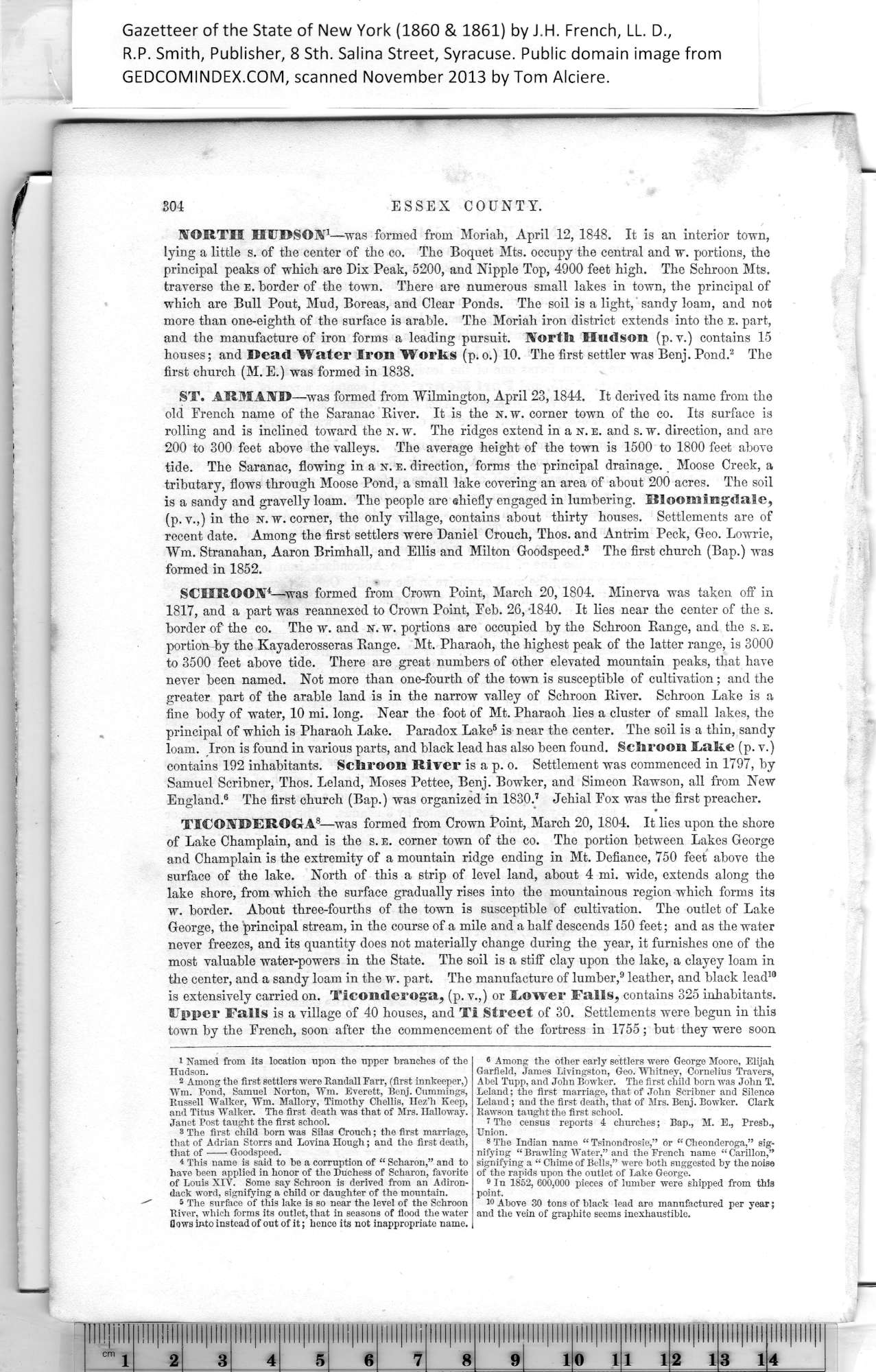|
304 ESSEX COUNTY.
MORTH HUDSON1—was formed from Moriah, April 12, 1848. It is an interior town,
lying a little s. of the center of the co. The Boquet Mts. occupy the central and w. portions, the
principal peaks of which are Dix Peak, 5200, and Nipple Top, 4900 feet high. The Schroon Mts.
traverse the e. border of the town. There are numerous small lakes in town, the principal of
wbich are Bull Pout, Mud, Boreas, and Clear Ponds. The soil is a light, sandy loam, and not
more than one-eighth of the surface is arable. The Moriah iron district extends into the e. part,
and the manufacture of iron forms a leading pursuit. North Hudson (p. v.) contains 15
houses; and Dead Water Iron Works (p. o.) 10. The first settler was Benj. Pond.2 The
first church (M. E.) was formed in 1838.
ST. ARMAID—was formed from Wilmington, April 23,1844. It derived its name from the
old French name of the Saranac River. It is the n.w. corner town of the co. Its surface is
rolling and is inclined toward the n. w. The ridges extend in a n. e. and s. w. direction, and are
200 to 300 feet above the valleys. The average height of the town is 1500 to 1800 feet above
tide. The Saranac, flowing in a n. e. direction, forms the principal drainage. Moose Creek, a
tributary, flows through Moose Pond, a small lake covering an area of about 200 acres. The soil
is a sandy and gravelly loam. The people are shiefly engaged in lumbering. Hloomingdale,
(p.v.,) in the n.w. corner, the only village, contains about thirty houses. Settlements are of
recent date. Among the first settlers were Daniel Crouch, Thos. and Antrim Peck, Geo. Lowrie,
Wm. Stranahan, Aaron Brimhall, and Ellis and Milton Goodspeed.8 The first church (Bap.) was
formed in 1852.
SCHROON4—was formed from Crown Point, March 20, 1804. Minerva was taken off in
1817, and a part was reannexed to Crown Point, Eeb. 26, -1840. It lies near the center of the s.
border of the co. The w. and n. w. portions are occupied by the Schroon Range, and the s. e.
portion -by the Kayaderosseras Range. Mt. Pharaoh, the highest peak of the latter range, is 3000
to 3500 feet above tide. There are great numbers of other elevated mountain peaks, that have
never been named. Not more than one-fourth of the town is susceptible of cultivation; and the
greater part of the arable land is in the narrow valley of Schroon River. Schroon Lake is a
fine body of water, 10 mi. long. Near the foot of Mt. Pharaoh lies a cluster of small lakes, the
principal of which is Pharaoh Lake. Paradox Lake2 is near the center. The soil is a thin, sandy
loam. Iron is found in various parts, and black lead has also been found. Sckroon Lake (p. v.)
contains 192 inhabitants. Schroon River is a p. o. Settlement was commenced in 1797, by
Samuel Scribner, Thos. Leland, Moses Pettee, Benj. Bowker, and Simeon Rawson, all from New
England.3 The first church (Bap.) was organized in 1830.4 Jehial Fox was the first preacher.
TICONDEROGA8—was formed from Crown Point, March 20, 1804. It lies upon the shore
of Lake Champlain, and is the s. e. corner town of the co. The portion between Lakes George
and Champlain is the extremity of a mountain ridge ending in Mt. Defiance, 750 feet above the
surface of the lake. North of this a strip of level land, about 4 mi. wide, extends along the
lake shore, from which the surface gradually rises into the mountainous region which forms its
w. border. About three-fourths of the town is susceptible of cultivation. The outlet of Lake
George, the principal stream, in the course of a mile and a half descends 150 feet; and as the water
never freezes, and its quantity does not materially change during the year, it furnishes one of the
most valuable water-powers in the State. The soil is a stiff clay upon the lake, a clayey loam in
the center, and a sandy loam in the w. part. The manufacture of lumber,9 leather, and black lead10
is extensively carried on. Ticonderoga, (p. v.,) or Lower Falls, contains 325 inhabitants.
Upper Falls is a village of 40 houses, and Ti Street of 30. Settlements were begun in this
town by the French, soon after the commencement of the fortress in 1755; hut they were soon
|
6 Among the other early settlers were George Moore, Elijah
Garfield, James Livingston, Geo. Whitney, Cornelius Travers,
Abel Tupp, and John Bowker. The first child born was John T.
Leland; the first marriage, that of John Scribner and Silence
Leland; and the first death, that of Mrs. Benj. Bowker. Clark
Rawson taught the first school.
7 The census reports 4 churches; Bap., M. E., Presb.,
Union.
8 The Indian name “ Tsinondrosie,” or “ Cheonderoga,” sig¬
nifying “ Brawling Water,” and the French name “Carillon,”
signifying a “ Chime of Bells,” were both suggested by the noise
of the rapids upon the outlet of Lake George.
9 In 1852, 600,000 pieces of lumber were shipped from this
point.
10 Above 30 tons of black lead are manufactured per year;
and the vein of graphite seems inexhaustible. |
1
Named from its location upon the upper branches of the
Hudson.
2
The surface of this lake is so near the level of the Schroon
3
River, which forms its outlet, that in seasons of flood the water
4
flows into instead of out of it; hence its not inappropriate name.
|
